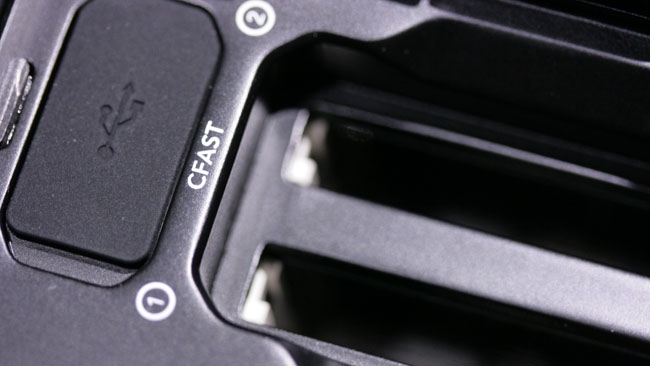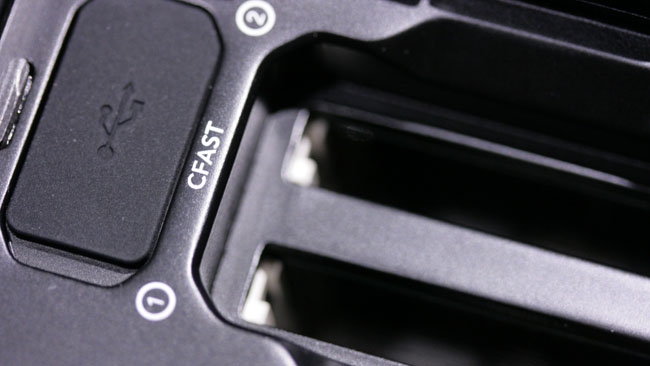
 Filling these holes on the URSA Mini is an expensive business
Filling these holes on the URSA Mini is an expensive business
CFast should be the great universal flash card format that solves many problems across the industry but it remains stubbornly, annoyingly expensive. Phil Rhodes investigates.
The world has too many flash card formats in it. That's something we've talked about before, and it's becoming a significant, and often unnecessary, expense associated with camera ownership. In this scenario, a generic industry-standard format like CFast should solve a lot of problems, but it's still stubbornly expensive. What's going on?
CFast is more or less the successor format to compactflash, which is to date probably the best way to buy reasonably fast flash storage at reasonable prices. There have been formats that are sturdier, cheaper and faster, particularly SD and its successors down to SDXC, which are very affordable per megabyte in their slower incarnations. In theory, a UHS-II SDXC card could operate at up to 312MB/s, although most real-world examples manage perhaps 250MB/s.
The fastest compactflash, marked UDMA 7 or 1000x, tops out at about 150-160MB/s, and that's a limitation of the electronic interface, not the underlying flash memory. Now, that's a healthy amount of data for an HD video stream – the HDCAM-SR tape format, in its most exotic variety, only records 100MB/s and is considered pretty good.
Unfortunately, that's insufficient for, say, uncompressed 4K RAW. A 4096 by 2160 Bayer image at 12 bits per pixel is 12.67MB per frame, or 303MB/s at 24fps. None of these card formats, except CFast, can do that. A 2.5” SSD absolutely can, and this is where devices like Atomos' 4K recorders, Convergent Design's Odyssey devices, and other such things score. The Serial ATA interface used by these devices is a seven-pin serial version of the old 40- or 80-pin ATA interface used for hard disks and the original compactflash cards. In its most recent versions, SATA is very capable. The now-common version 3 is capable of up to 600MB/s, although the underlying flash devices are often not that fast. Even so, with the flash itself often capable of 400-500MB/second write speeds, it is generally capable of uncompressed, high-bit-depth 4K raw Bayer recording at conventional frame rates.
With an eye to the near future, with laptop and desktop computers moving away from full-size SATA devices, we're increasingly in a world of mSATA and M.2 drives. These are fundamentally a finger of circuit board with a bunch of flash chips and a controller. mSATA – minitaure SATA – is electronically identical to SATA, but the newer M.2 specification provides PCI Express lanes as well, meaning that the device has access to the same sort of performance as a plug-in expansion card. Various M.2 devices are implemented in various ways, but the maximum possible performance is very high. In theory, with four lanes of PCIe 3.0 available, nearly four gigabytes per second could be transferred (enough for 315 frames per second of uncompressed 12-bit raw Bayer 4K). That's fast, but M.2 is not, or at least not yet, a pluggable flash card standard.
Bringing SATA to a smaller format
CFast is an attempt to bring the more recent, higher-performance SATA standard to a very small card format. A CFast card is fundamentally the same thing as a compactflash card, but with rather faster flash memory and using the 600-megabyte/s, version 3 SATA interface. This means CFast cards can do things that compactflash can't, such as uncompressed 4K raw Bayer recording. This is important if you're a camera manufacturer such as Blackmagic who wants to make a camera such as Ursa and offer that feature. There is, however, a bit of a problem.
When new things are launched, there's the sad reality that some of them will be successful, and some of them won't. When CFast was launched it was expensive. This wasn't unexpected at the time, but the problem is that since then they haven't really become that much less expensive. We might have hoped that increased adoption would drive demand and push down prices, as it has for other card formats, but while this has happened to a degree CFast storage is still much too expensive. For instance, a 256GB Samsung EVO 850 SSD currently sells for perhaps £80 and reads and writes at over 500MB/second. A Lexar Professional 3400x 256GB CFast card with fundamentally similar capability sells, right now, for considerably over £500. This is partly because the CFast card is physically much smaller than the SSD and Lexar must use hard-to-make devices to create it, but at some level, SSDs are smaller than most tape formats ever were and most camera crew couldn't care less about size at this level.
There are arguments to be made that the SSD is not intended for repeated insertion and removal, and that its connectors may wear quickly. This was probably true of early SSDs and even the 2.5” mechanical SATA disks which were usable on early Atomos recorders while recording less-demanding compressed formats. These disks were intended for use in RAID arrays where the devices are largely installed and left alone, and only swapped out on failure. Practical experience, however, suggests that reasonable handling procedures can keep failures down to a manageable level.
Manufacturers have since recognised that 2.5” SATA SSDs are being widely used as removable storage and more recent devices are sturdier. Caddy systems, such as the slide-in plastic cases supplied by Atomos also help. Other solutions include that adopted by Sound (or is that Video) Devices: they sell caddies to take mSATA devices (which are not really hot-swappable) and provide a USB connection. mSATA devices are cost-comparable with SSD, and USB 3.0 is about as fast as SATA 3, with the additional advantage that these caddies can simply be plugged into any available USB port for offloading. Cracking idea. Full marks.
This may be permanent
If our suspicions regarding uptake of CFast are accurate, it may never come down in price; it may, instead, simply drift out of the market and become a format that never quite made it. There should be no desire to see this happen, as a faster descendant of compactflash is entirely appropriate and desirable, but it wouldn't be the first time.
The compactflash association has confounded matters by becoming involved in the XQD card format, which is incompatible with CFast but targets something of the same market. Most current XQD is slower than CFast, but extensions to the standard support transfer rates up to 1000MB/second. That's good, but XQD doesn't seem to have gained much traction, having been used mainly by Sony as an alternative to SxS for lower-bitrate modes of some XDCAM cameras and in at least one Nikon DSLR.
At some point, there needs to be a considerable standardisation effort. The pile of flash formats that currently exists helps nobody and prevents people from making long-term investments in storage, making it difficult to obtain more in emergencies and creates problems when offloading. That's before we've even considered the situation with proprietary flash formats which are, by now, unnecessary outside seriously esoteric circumstances like the Vision Research high speed cameras.
In the meantime, desperate efforts such as the C-Box CFast-to-SSD adaptor which was successfully kickstarted earlier this year serve as an indication of how far people are willing to go to avoid the swingeing cost of CFast. Since CFast uses SATA as its electronic interconnect standard, C-Box is nothing but a connector converter and power supply, and at $499, it's not cheap.
Although it's cheaper than a single CFast card.
Tags: Production


Comments